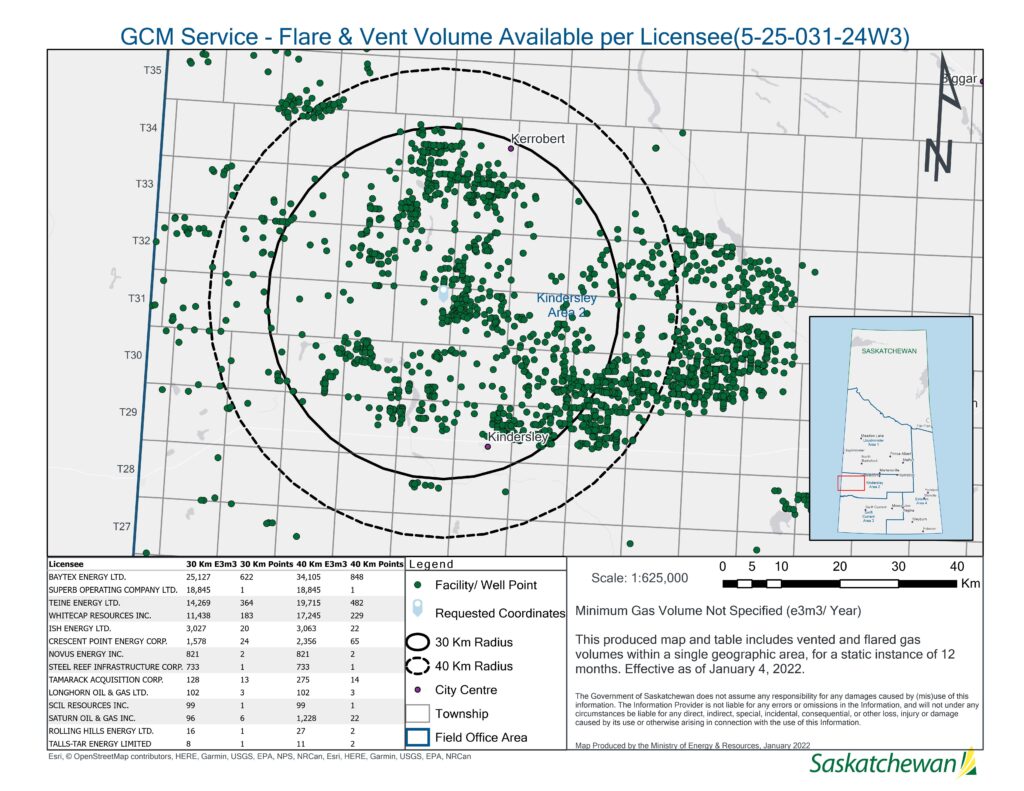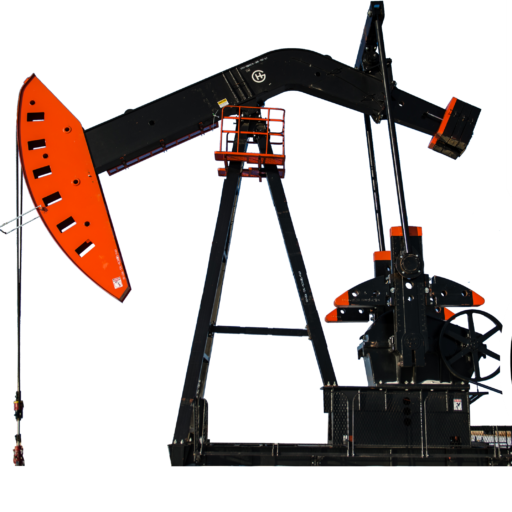Brian Zinchuk is editor and owner of Pipeline Online

Gas Commercialization Mapping (GCM) Service example. Ministry of Energy and Resources
REGINA – As the federal government moves to dramatically reduce methane emissions, they are using data to regulate Saskatchewan that is not actually Saskatchewan-specific, and that could be a big problem for this province. Thus, to address that, the provincial government announced two programs on March 14 to address it.
As methane is considered a greenhouse gas far more potent than carbon dioxide, and natural gas is principally methane, strategies to minimize the release of unburned natural gas have been a key consideration in strategies meant to reduce anthropogenic (manmade) climate change.
For years, the Government of Saskatchewan has been working on programs to reduce methane emissions, and on March 14, two more were announced, with the goal of enhancing Saskatchewan-specific data.
The Saskatchewan Emissions Inventory will further expand methane modelling and measurement in the province, while the Gas Commercialization Mapping (GCM) Service will highlight methane-concentrated areas and allow the energy sector to better plan and collaborate on scaled methane capture and commercialization projects, including with Crown utilities.
Minister of Energy and Resources Bronwyn Eyre spoke to Pipeline Online about this on March 15. Asked if this was information the province already had and the reason behind it, Eyre replied the province had been using an unwieldy spreadsheet format. “This new mapping service, the Gas Commercialization Mapping Service, will make it easier to file and easier to find information. It maps it out for the sector much more. So it’s for ease of filing and ease of access to information.”
“There is a broader issue here,” She added. “We need Saskatchewan-specific science to make sure that if we’re facing future emissions reduction policies and regulations for the upstream oil and gas sector, that we have the most accurate and the most representative data. Because right now, the federal government is making emissions inventories for us, based on science obtained from other jurisdictions, Texas, Alberta, and so on. So it’s really important to recognize that our sector is unique, and there’s a specific geology here, specific infrastructure needs that that have to be evaluated to make sure that emissions aren’t being overestimated. That’s a big concern.
- 0098 SASPO-2874_Self Serve Campaign_New Connects_Youtube_v30098 SASPO-2874_Self Serve Campaign_New Connects_Youtube_v3
- 0100 Turnbull Project Manager0100 Turnbull Project Manager
- 0099 Mryglod Steel 1080p0099 Mryglod Steel 1080p
- 0097 Eagle Sky Ventures LTD0097 Eagle Sky Ventures LTD
- 0095 Fast Trucking nearly 70 years good at it0095 Fast Trucking nearly 70 years good at it
- 0053 Kingston Midstream Westspur Alameda Click Before You Dig0053 Kingston Midstream Westspur Alameda Click Before You Dig
- 0092 Turnbull projects big and small0092 Turnbull projects big and small
- 0046 City of Estevan This is Estevan Teaser0046 City of Estevan This is Estevan Teaser
- 0087 Lori Carr Coal Expansion0087 Lori Carr Coal Expansion
- 0077 Caprice Resources Stand Up For Free Speech0077 Caprice Resources Stand Up For Free Speech
- 0076 Latus only0076 Latus only
- 0061 SIMSA 2024 For Sask Buy Sask0061 SIMSA 2024 For Sask Buy Sask
- 0055 Smart Power Be Smart with your Power office0055 Smart Power Be Smart with your Power office
- 0051 JML Hiring Pumpjack assembly0051 JML Hiring Pumpjack assembly
- 0049 Scotsburn Dental soft guitar0049 Scotsburn Dental soft guitar
- 0041 DEEP Since 2018 now we are going to build0041 DEEP Since 2018 now we are going to build
- 0032 IWS Summer hiring rock trailer music
- 0022 Grimes winter hiring
- 0021 OSY Rentals S8 Promo
- 0018 IWS Hiring Royal Summer
- 0013 Panther Drilling PO ad 03 top drive rigs
- 0006 JK Junior
- 0002 gilliss casing services0002 gilliss casing services
- 9002 Pipeline Online 30 sec EBEX9002 Pipeline Online 30 sec EBEX
- 9001
“Right now, we have measures that the industry makes, and they report about the volumes of gas that’s vented or combusted or used at the facility level. But the emissions inventory research that we’ve announced will just provide more depth, more detail. And this will be necessary if there are more reductions requested, demanded, as federal regulations become more stringent after 2024. And there is the new federal commitment to reduce methane emissions by 75 per cent by 2030,” she said.
Eyre pointed out her biggest frustration is with the data sharing, or lack thereof, by the federal government. She pointed out the federal government is making assumptions about Saskatchewan, but not using Saskatchewan-specific data. “They are not sharing the data they are using. And that is, from our perspective, not conducive to any kind of workable cooperation. We need to have the transparency of the data that they’re using.”
If the Saskatchewan Research Council can show the work they’ve done, and who they’re working with in the sector, the mapping and the data, Eyre said, “It’s more difficult to impose data on us. So that’s a huge part of this.”
Eyre’s been talking about this for many months now, and the province’s announcement is the fulfillment of that discussion.
Referring to the federal government, she said, “If you’re going to keep announcing things and doing things potentially to us, or saying you will, then we need to be able to see the data you’re using. And this is, I think, a proactive step to addressing that.
“In terms of the Gas Commercialization Mapping Service, that highlights areas with methane, where there are higher concentrated areas of it, where companies can capture and commercialize where there might be opportunities. We’ll have the custom mapping service of the flared and vented volumes for the most recent 12 months then a summary of all the companies.
“We received a number of enquiries between 2019 and 2021, over the last few years about potential locations for sustainable gas supply for methane capture and gas commercialization projects,” she said.
Questions included gas volume thresholds, distances between volume sources, and a list of companies associated with the volumes. This will be useful information for midstreamers and producers, she explained. It can be customized to minimum gas volumes, point coordinates, legal land descriptions and more. “It has to get pretty in the weeds. It has to get pretty specific if we’re going to establish our own our own data inventory and data system,” she said.
Ultimately, the province would like to see more gas gathering done. And by providing the best data for both the Ministry and the companies involved, Saskatchewan can get “a really true picture of what we have, and what we’re reporting,” she said.
“These two initiatives will support Saskatchewan’s already strong record on methane, which includes a reduction in emissions by 50 per cent five years ahead of schedule,” Eyre said. “These two provincial initiatives will help mitigate the negative impacts of these inaccurate representations.”
The Ministry of Energy and Resources (ER) will apply acquired data to generate a point-in-time database of Saskatchewan emissions information, a list of the larger sources of emissions to assist in determining economic options for emission reduction, a foundation for future, detailed emissions reporting, scenarios for zero-flaring infrastructure scenarios, and data on select industry equipment.
The Saskatchewan Research Council (SRC), through a $350,000 grant provided by ER, will begin this spring to compile information for the emissions inventory, which ER will use internally to help confirm and inform current and future emissions reductions from the upstream oil and gas sector.
The GCM Service, which will provide critical geographic information to assist in the development of methane capture and commercialization projects, will be able to generate customized maps of vented and flared methane gas volumes, as well as a table of licensees within a specified geographic area. This initiative fulfills commitments under the Saskatchewan Methane Action Plan (MAP), namely, providing geographic information of regions in the province where volumes of methane gas venting and flaring occur and assisting stakeholders to develop methane capture and commercialization projects within joint planning areas.
The GCM Service can be accessed here at saskatchewan.ca/gas-commercialization-mapping.
The government described MAP as “an ambitious, made-in-Saskatchewan program, which includes The Oil and Gas Emissions Management Regulations (OGEMR) and achieved federal equivalency in 2020. It includes an outcome-based regulatory regime to reduce greenhouse gas emissions from flaring and venting in the upstream oil and gas industry by 40 to 45 per cent from 2015 levels by 2025, the equivalent of 4.5 million tonnes of carbon dioxide annually.”
In October 2021, the federal government announced a plan to further reduce oil and gas methane emissions by at least 75 per cent below 2012 levels by 2030.
- 0098 SASPO-2874_Self Serve Campaign_New Connects_Youtube_v30098 SASPO-2874_Self Serve Campaign_New Connects_Youtube_v3
- 0100 Turnbull Project Manager0100 Turnbull Project Manager
- 0099 Mryglod Steel 1080p0099 Mryglod Steel 1080p
- 0097 Eagle Sky Ventures LTD0097 Eagle Sky Ventures LTD
- 0095 Fast Trucking nearly 70 years good at it0095 Fast Trucking nearly 70 years good at it
- 0053 Kingston Midstream Westspur Alameda Click Before You Dig0053 Kingston Midstream Westspur Alameda Click Before You Dig
- 0092 Turnbull projects big and small0092 Turnbull projects big and small
- 0046 City of Estevan This is Estevan Teaser0046 City of Estevan This is Estevan Teaser
- 0087 Lori Carr Coal Expansion0087 Lori Carr Coal Expansion
- 0077 Caprice Resources Stand Up For Free Speech0077 Caprice Resources Stand Up For Free Speech
- 0076 Latus only0076 Latus only
- 0061 SIMSA 2024 For Sask Buy Sask0061 SIMSA 2024 For Sask Buy Sask
- 0055 Smart Power Be Smart with your Power office0055 Smart Power Be Smart with your Power office
- 0051 JML Hiring Pumpjack assembly0051 JML Hiring Pumpjack assembly
- 0049 Scotsburn Dental soft guitar0049 Scotsburn Dental soft guitar
- 0041 DEEP Since 2018 now we are going to build0041 DEEP Since 2018 now we are going to build
- 0032 IWS Summer hiring rock trailer music
- 0022 Grimes winter hiring
- 0021 OSY Rentals S8 Promo
- 0018 IWS Hiring Royal Summer
- 0013 Panther Drilling PO ad 03 top drive rigs
- 0006 JK Junior
- 0002 gilliss casing services0002 gilliss casing services
- 9002 Pipeline Online 30 sec EBEX9002 Pipeline Online 30 sec EBEX
- 9001
